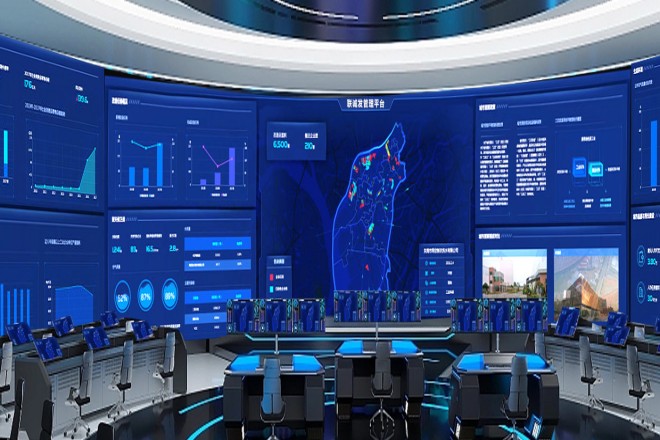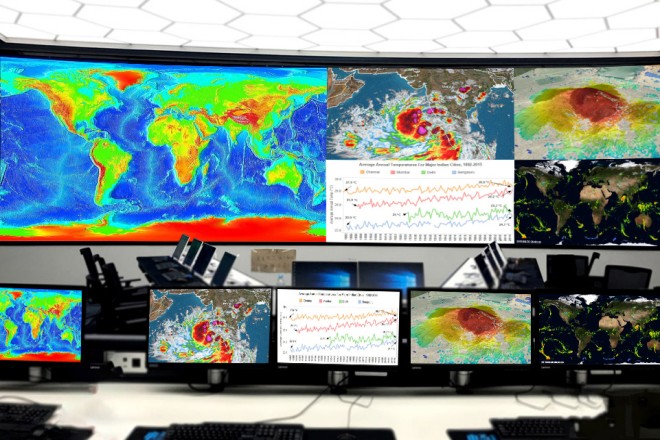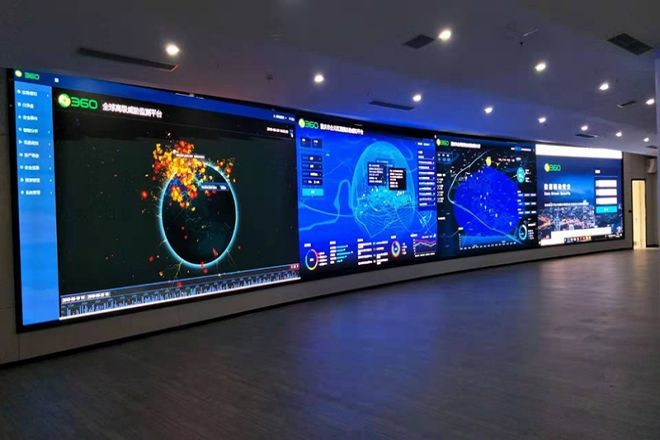مقدمة

In the control center, every second of the information display is crucial. As the core tool for information transmission, the performance of the شاشة عرض LED directly affects the efficiency and accuracy of decision-making.
With the development of technology, the functions of LED display screens have evolved from single image display to the current high-definition video, real-time data monitoring, and interactive operation. However, with the increase in functions, the performance requirements of the display screen are also getting higher and higher.
This article will explore how to optimize the LED display screen in the control center to ensure high efficiency and high reliability of information transmission.
1. The role of the LED display screen in the control center

In the busy and complex control center environment, the LED display screen is like a huge information window, clearly presenting key data, real-time conditions, and emergency instructions to all relevant personnel.
1). Real-time information display: A clear information window
Imagine that there may be multiple systems running in the control center at the same time, such as monitoring systems, environmental monitoring systems, production management systems, etc. Each system is constantly generating data.
The LED display screen is like a super large electronic bulletin board, which can display this data in real-time in the form of graphics, text, numbers, etc. For example, in the environmental monitoring system, the display screen can display parameters such as temperature, humidity, and air quality in real-time.
In the production management system, it can display the operating status of the production line, production statistics, and other information. In this way, the staff only need to look up to quickly grasp the current situation without having to check the display screens or reports of each system one by one.
2). Data monitoring: A 24-hour guardian
The LED display screen not only displays data but also bears the heavy responsibility of data monitoring. It is like a tireless sentinel, monitoring the changes of various data 24 hours a day.
Once the data is abnormal, such as the temperature of a certain monitoring point suddenly rising, the operating parameters of certain equipment exceeding the normal range, etc., the display screen will remind the staff in a striking way (such as changing color, flashing, etc.).
In this way, the staff can immediately find the problem and take measures to prevent the situation from further deteriorating.
3). Emergency notification: Alarm in crisis
In an emergency, time is life. The LED display screen can convey emergency information to everyone for the first time. For example, when a fire occurs, the display screen will immediately display the words “Fire alarm!
Please evacuate immediately!” accompanied by a strong alarm sound. In this way, both staff and visitors can respond quickly and evacuate safely according to the predetermined evacuation route.
Similarly, in emergency situations such as natural disasters and equipment failures, the display screen can also play the same role in ensuring timely communication of information and effective response.
4). Operation instruction transmission: Accurate and accurate commander
In the control center, multiple systems or equipment often need to be remotely operated. The LED display screen can be used as a display platform for remote operation instructions.
When an operation needs to be performed, the staff only needs to enter the instructions on the console, and the instructions will be immediately displayed on the LED display screen.
At the same time, the display screen can also display information such as detailed steps, precautions, and expected results of the operation. In this way, the operator can clearly understand the operation requirements and perform the operation accurately and accurately according to the instructions.
This not only improves work efficiency but also reduces the risk of misoperation.
2. Current challenges and requirements of LED display screens in control centers
1). High-definition requirements
Imagine that you are in a control center and need to monitor the images from multiple cameras or view detailed production data charts.
If the clarity of the display screen is not high enough, the details in the picture may become blurred, such as faces becoming difficult to recognize, and lines and text in data charts may become difficult to read.
Therefore, you need a high-definition LED display. It’s like your HDTV at home but more demanding because it needs to display more information clearly and with finer details. A high-definition display ensures that every pixel is clearly visible, whether it is a complex image or tiny text.
2). Fast response time
In the control center, time is efficiency. If you are monitoring an emergency, such as a fire or equipment failure, the response time of the display becomes critical. If the display updates data or alarm information too slowly, you may miss the best time to respond.
Therefore, you need an LED display with a fast response time. This means that when there is new data or alarm information, the display can be updated and displayed immediately, allowing you to respond quickly.
Just like when you are playing a video game, if the game screen freezes, you will feel very uncomfortable; similarly, in the control center, we also need a smooth and unobstructed display to ensure the real-time information.
3). High reliability
Control centers usually need to operate 24 hours a day, which requires the display to have extremely high reliability. If the display fails at a critical moment, it may cause the entire control center to be paralyzed, causing immeasurable losses.
Therefore, you need a highly reliable LED display. This means that the display needs to use high-quality materials and advanced manufacturing processes to ensure its long-term stable operation.
At the same time, a complete monitoring and maintenance mechanism needs to be established to prevent failures and quickly resume operation when failures occur. Just like the light in your home, although you rarely notice its existence, it needs to work reliably all the time to provide you with light.
4). Easy to operate
The operators in the control center may come from different professional fields and backgrounds, and they may have different understandings and habits of the operation interface and operation process of the display.
If the operation of the display is too complicated or does not conform to their usage habits, it may increase their operating burden and increase the risk of errors.
Therefore, you need an easy-to-operate LED display. This means that the control interface of the display needs to be designed to be intuitive, concise, and easy to understand so that operators can quickly get started and operate accurately.
At the same time, rich help documents and training resources need to be provided to support operators’ learning and use.
Just like when you use a mobile phone or computer, even if you have not used a specific application or function before, as long as the interface is designed to be friendly enough and provides enough helpful information, you can quickly master it.
3. Control center LED display optimization strategy

1). Improved دقة
When we say improved resolution, we mean choosing LED displays that have denser pixels and can show more details.
Imagine you are looking at a painting. If the lines and color blocks on the painting are large, the details will be lost, but if the lines and color blocks are small and fine, you can see more details.
In the same way, a high-resolution LED display is like a fine painting, which can show more image details, such as clearer text, finer image edges, etc.
- المميزات:
With higher clarity, information is easier to identify and understand.
Improved work efficiency because operators do not need to spend extra time to identify blurry information.
2). Enhanced سطوع adjustment
The brightness adjustment function allows us to adjust the brightness of the LED display according to changes in ambient light. During the day when the light is strong, we can increase the brightness of the display to ensure that the information is clearly visible.
While at night or in indoor environments with darker light, we can reduce the brightness to reduce glare and save energy. This function can be automatic, through sensors to sense the ambient light and automatically adjust the brightness, or it can be manual, and the operator can adjust it as needed.
- المميزات:
Improved visibility of the display in different light conditions.
Helps save energy and reduce consumption, especially in low-light environments.
3). Improve color accuracy
Color accuracy refers to the ability of the display to accurately restore the colors in the original image or video. To ensure color accuracy, we need to regularly calibrate the display.
This usually involves using professional color management software and calibration equipment to accurately measure and adjust the color of the display to ensure that its color performance is consistent with the original image.
- المميزات:
Improves the color reproduction of the display and makes the image more realistic.
Helps control center personnel to more accurately identify information in the image.
4). Upgrade hardware
Over time, the hardware components of the LED display may become obsolete due to aging, wear, or technological advancement. In order to maintain the optimal performance of the display, we need to regularly check and replace aging hardware components.
This may include key components such as LED lamp beads, circuit boards, and power supplies. By upgrading the hardware, we can improve the key indicators of the display such as brightness, contrast, and color reproduction, and also help extend the service life of the display.
- المميزات:
Improves the overall performance and stability of the display.
Extends the service life of the display and reduces replacement costs.
5). Software Upgrade
Software upgrade refers to installing a new version or patch for the control software of the LED display to fix known problems, add new features, or improve performance. This can usually be done by downloading the update package from the network and installing it in the display control system.
Software upgrades are essential to maintaining the compatibility and security of the display, as new software versions may include support for new operating systems, new file formats, or new security threats.
- المميزات:
Improved compatibility and performance of the display.
Enhanced security of the display and reduced risk of hacker attacks.
6). Redundant system design
Redundant system design refers to setting up backup LED displays or key components in the control center so that they can quickly switch to backup devices when the main display or component fails.
This design is similar to configuring a backup power supply or hard drive for a computer to improve the reliability and stability of the system. In a redundant system, the main and backup displays are usually connected to the same control system and can be switched automatically or manually when needed.
- المميزات:
Improved reliability and stability of the control center.
Reduces interruptions and losses caused by display failures.
خاتمة
Optimizing the LED display in the control center is not just a process of technical upgrades; it is also a process of improving overall business performance and responsiveness.
By upgrading and maintaining the resolution, brightness, color accuracy, hardware, and software of the display, we can ensure that the control center can provide clear, accurate, and real-time information at all times.
Such optimization not only improves the convenience and efficiency of operation but also enhances the control center’s ability to respond to emergencies.
أخيرًا، إذا كنت تريد معرفة المزيد عن شاشات LED، يرجى الحصول على اتصال معنا.
